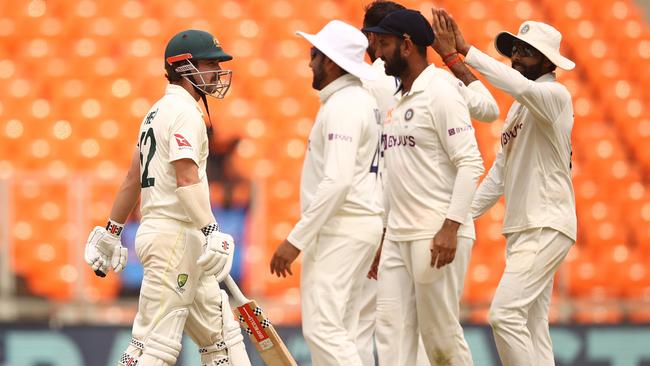Like the stadium, we were all left feeling empty
Pitch fixing is part of the BCCI’s obsession with control and it turned a potential series thriller into a dull draw.

In Ahmedabad on Monday, a Test match ended as absurdly as it began, completing its arc from the prime ministers’ everything-is-awesome opening pantomime to the players’ agreement on a nothing-is-happening conclusion.
The fourth Test at Narendra Modi Stadium has not been altogether futile: two grand old stagers, Usman Khawaja and Virat Kohli, compiled big hundreds, and two 23-year-olds, Shubman Gill and Cameron Green, made maiden centuries, substantiating their advance claims to being players of the next generation.
Otherwise, the final day played out as a variation on the rest of the series: the players pitted less against each other than against the conditions, Travis Head and Marnus Labuschagne not so much batting with intent as batting within tent – the little enclosures of their creases, the slight deviations of the turn.
Ravi Ashwin, in pursuit of his 700th international wicket, went to work – as that lovely Indian writer Rajan Bala once described Srinivas Venkataraghaven bowling – like a dentist trying to extract a stubborn tooth.
But neither he nor Axar Patel, on the ground where two years ago he took 20 wickets for 198 across consecutive matches on tailor-made turners against England, could do better than a wicket each.
Fast bowlers did not add to the 18 wickets that the pace attacks of both sides have managed across four Tests. As on a long intercontinental airline flight, every time you looked up there seemed longer to go. When the players shook hands at 3.20pm, the match was a suitable case for euthanasia.
Thank the Board of Control for Cricket in India’s idee fixe with what might be described as pitch-fixing. The pitches have not been altogether terrible in this series – I have seen worse, and the cricket, thanks to the quality of the players, has at times been absorbing.
But neither have the pitches been as good as they should have. And as the dreary tarmac rolled out for this match has testified, the habit of designing surfaces to specifications is exceedingly hard to break.
It is like sawing a bit off one table leg; no matter how you adjust the other three legs, the table is never quite level again.
In the currency of this series, New Zealand has, firstly against England and now Sri Lanka, played two of the most exciting five-day Tests of all time, on pitches where batters made hundreds, both fast and slow bowlers took five-fors, and the result was in doubt til the last ball.
This Border-Gavaskar Trophy pivoted from a Test of 2½ days to a Test that would, if permitted, have lasted 2½ weeks. Curators can do better, and they should be allowed to.
In any event, this is not a problem of acumen so much as of ideology. It’s not a coincidence that the BCCI is the only cricket board in the world that maintains the old-fashioned “control” in its title.
From its communications to its commentators, it is obsessed with orchestrating every process, managing every variable, flattening every wrinkle – ever more so given its interpenetration with the ruling Bharatiya Janata Party.
Pitch preparation represents the continuation of such policies, invincibility at home having become an important symbol of Indian hegemony. Oh, sorry, those with delicate sensibilities would prefer us to keep politics out of sport – everyone, that is, except politicians, who are just fine with it.
Anyway, the BCCI got what it bargained for here on Monday. The world’s largest cricket stadium became the world’s emptiest, a giant vortex of uninterest, all the better to see the untenanted vistas of saffron seating, but confirmation that this arriviste’s vanity project was hardly the place for a game so important.
Twenty-two years since Australia’s last Test at Eden Gardens in Kolkata, and 19 years since Australia’s last Test at Wankhede Stadium in Mumbai, the vagaries of Indian venue selection remain a riddle inside a mystery wrapped in an enigma.
Not that the BCCI’s potentates will care. After all, it’s only 17 days until Gujarat Titans commence the defence of their Indian Premier League title on this same ground. They’re minting it.
But you did feel for the players, going through such futile motions. By the afternoon, even Ashwin’s expressive shoulders were slumping a little every so often, while Rohit Sharma looked as desperate for inspiration as a writer staring at a blinking cursor – and I use the metaphor advisedly.
Khawaja looked on, with his weirdly non-specific ‘lower leg injury, which could be anything from a stubbed toe to gangrene. Shreyas Iyer again sat the day out with his bad back, a setback for an exciting player, as getting into India’s top six has historically been like trying to become a fifth Beatle or an additional musketeer.
It all made for a sorry conclusion to a series that, at times, lived up to the vaunts that it, and not the match starting at the Oval on June 7, was the proper climax of the World Test Championship. We must await that rematch in England to learn the real gap between these two teams.



To join the conversation, please log in. Don't have an account? Register
Join the conversation, you are commenting as Logout